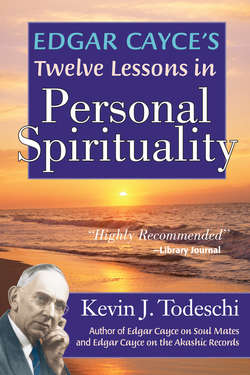Читать книгу Edgar Cayce's Twelve Lessons in Personal Spirituality - Kevin J. Todeschi - Страница 23
На сайте Литреса книга снята с продажи.
KNOWING OURSELVES THROUGH OTHERS
ОглавлениеIt may come as a surprise, but one of the leading ideas contained within the Cayce readings is that it is through others that we most often come to know ourselves. Whether it is through learning about love in the face of a child, or growing in patience through our experiences with a friend, it is through our interactions with others that we become aware of our shortcomings, our faults, our abilities, and our talents. It is through our encounters with others that we come to realize what we need to work on, as well as what it is with which we have to work. It is through other people that we grow in our awareness of our relationship with God and come to know ourselves.
According to the readings, there is an undergirding dynamic in every human relationship—a universal law—which is described as “Like attracts like.” What this means is that everything we put out through thought or deed comes back to us. This should not really come as a surprise when we consider our co-creative abilities in creating our environment. What may be challenging, however, is the idea this suggests: we can see our own strengths and weaknesses in other people:
Remember—these are as the unchangeable laws: As ye mete to others, it comes back to thee. As ye would that others should do to thee, do ye even so to them. This applies whether in family or in just acquaintance, or associates of any kind. Know that the fault ye find in others is a reflection of a fault in thyself. Be to others just as you would have others be to thee, and ye will remove much of that. Do not hold the idea, “Well, I know what they are going to say or do, but I’ll do as best I can.” Disregard that! know the spirit with which ye do a thing is the spirit that will respond to thee! 1688-9
Cayce stated that individuals in our environment literally act as a mirror. The people in our life who may be the most frustrating to us, are frustrating because we are seeing in them a portion of ourselves that we have somehow overlooked or refused to deal with. Conversely, the people in our life that we truly admire are showing us a reflection of some quality we can utilize within ourselves. Although this concept might be difficult to believe at first, all one need do is to remember that even my own worst enemy has a best friend, and even my best friend has someone who doesn’t like them. Why? The answer has to do with the focus of our perception.
Each of us is drawn to perceiving specific traits in individuals for a reason. In fact, whenever we have an emotional response to another person (positively or negatively) we can be certain that there is something more for us to learn. If we want to see what we need to work on spiritually, we need to look around at the people in our lives that drive us crazy. If we want to see what we have to work with, we need to look around at the people whom we truly admire. In this manner, we will begin to see our own strengths and weaknesses portrayed in others. Becoming aware of this dynamic can give us an entirely different attitude about all of humankind:
For the first law is, “Like begets like.” And what ye sow, ye shall reap. It is, then, how ye mete that ye reap in thine relationships one to another . . . Then, the first law of knowing self, of understanding self, is to become more and more sincere with that thou doest in the relationships one to another. For the proof of same is the fruit thereof. And when thou hast found the way, thou showest the way to thy brother. 261-15
Personal reflection can be a powerful tool for coming to know oneself. Thinking back over the words and the activities of each day we might ask ourselves: Why did I do this or that? Am I expressing the concepts of what I say (or think) I believe in my interactions with others? Would I have acted in front of someone I truly respect (perhaps even my Creator!) in the same manner that I acted toward a particular individual I don’t like? From the soul’s perspective, every person in the earth is my sister and my brother—am I treating them as such? We must remember that, in part, the people in our life hold the key to the process of our own growth and development:
Q. What must I do in order to know self better?
A. As self meditates upon the various activities of self, as to how oft self becomes the impetus of another’s activity, then there may be seen that self is understood, or not understood, as the activities of self have been. How oft in thine own self has thou been that, that impelled another to look within themselves as to whether they were in accord with that He would have them do? How oft hast thou made another think better of themselves? Not laud themselves, but think better of themselves? In this may one see self; for in magnifying Him self sees self as others may see self in self’s activities. 262-9
As we lose sight of our selfish interests in relationship to others we will be able to tap into that portion of our individuality that desires to be whole, that portion that desires true self-expression, that portion that desires to come to know itself.
